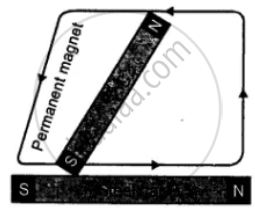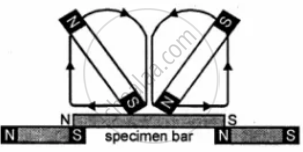Advertisements
Advertisements
Question
Describe various methods of magnetising a piece of iron.
Solution
METHODS OF MAGNETISATION:
- Single Touch Method: The specimen to be magnetized is placed flat on the table. A permanent bar magnet is taken and its one pole is placed on one end of the piece. The bar magnet is then drawn to the other end, keeping it in the inclined position as shown in the figure. The permanent magnet is then lifted and the process is repeated several times. The specimen is then turned over and the other side is also magnetized in the same way.
The specimen gets magnetized. Its starting end gets the same polarity as the polarity of the magnet touching it. The polarity at the other end of the specimen is opposite to that of the magnetizing pole.
- Divided Touch Method: The specimen to be magnetized is placed flat on a table. Opposite poles of two strong bar magnets of equal strength are placed together in the middle of the specimen. The ends of bar magnets are drawn towards the opposite ends of the specimen, keeping the bar magnets inclined as shown in the figure. The magnets are then lifted. The operation is repeated several times

The specimen is then turned over and the other side is also magnetized in the same way. The end of the specimen where the south pole of the bar magnet leaves, becomes north pole. Similarly, the end of the specimen where the north pole of the bar magnet leaves, becomes the south pole. For strong magnetization, the two ends of the specimen are supported on the two poles of two other bar magnets, such that the pole of each magnet being the same as that of the stroking magnet over it. - Double Touch Method: This method is almost similar to the divided touch method. The only difference is that a piece of wood or cork is placed between the two opposite poles of the permanent magnets. The magnets are then moved together from the middle to the one end and then to the other end without lifting them from the specimen as shown in the figure. This process is repeated several times.
The polarities on the end of the specimen are of the opposite nature to that of the nearer poles of stroking magnets figure. For strong magnetization, the specimen is mounted on two permanent bar magnets as mentioned in the divided touch method.
- Electrical Method of Magnetisation: The specimen to be magnetized is placed inside a long coil of insulated copper wire. A strong direct current is passed through the coil for some time when the specimen is magnetized.
If the specimen is a steel bar, it becomes a permanent magnet. However, if the specimen is a soft iron bar, it becomes a strong magnet, but it retains the properties of magnetism only so long as the current is passed through the coil. As soon as the current is stopped, it loses its magnetism.
The magnet formed by the passage of electric current by using soft iron core is called an electromagnet.
APPEARS IN
RELATED QUESTIONS
Fill in the blank to complete the sentence :
Unlike poles of a magnet ___________ each other.
Fill in the blank to complete the sentence :
A freely suspended magnet rests in the geographic ___________ direction.
What is magnetic induction?
Explain a suitable experiment of magnetic induction?
A magnet is carefully broken into two equal pieces as shown in the figure. How would the magnetic field strength of each piece compare with that of the original magnet? 
A conductor B is charged by bringing another charged body A in contact 
Explain the process of charging B.
How would you test whether a piece of steel was magnetised
(i) If you had a magnet?
(ii) If there was no magnet available.
Give scientific reason:
A charge can be obtained on a rubbed ebonite rod held in the hand but not on a rubbed metal rod held in the hand.
